Atlas Camera Support Rig
I am doing this short review after using this rig in the field forseveral months.
Background:
I had an urgent feature film shoot where there was lot of walking around shots through narrow staircases. So a steadicam would have been a problem. I saw the details in their site and shot an email to Michael Knowles the owner/inventor (yes the Atlas Camera support rig has got an approve patent).
Michael Knowles replied back I think the learning curve is dependent on you a little bit. Ive seen some people strap on anAtlasand with in minutes they get the feeling and know how to movewith it and then Ive seen others strap it on and I dont know if they will ever get super smooth walking shots. I think if you generally are able to get somewhat smooth shots while walking and doing handheld you will generally get even smoother shots walking fast and even running BUT I have to stress, TheAtlasis no replacement for a steadicam when it comes to really fast walking or running shots. TheAtlasis unique in that it gives the user a smoother handheld feel.
Having heard this, I ordered the Atlas Camera Support rig as Michael himself is a filmmaker.
Idea:
It is a simple idea where a flexible rod flexes a bit and supports the weight of your camera when attached/hung to the rod. So the vertical axis is more or less stable.
Details of the Rig:
The rig consists of two sets of rods, a vest to hold the rod in place and a strap to attach your rig to the rod. There is a white rod and a black rod. The white rod is for lower weight and the black for heavier cameras. Each rod comes in two pieces and needs to be screwed in to achieve the complete length. This two piece rod design also helps while traveling.
Cons:
1) When I got the rig, I just put the white rod and used a heavier set up to test and pulled it way beyond it can flex. As a result the outer coating of the white rod cracked.However the core remains strong and works. To be fair to the manufacturer, the correct practice of attaching the rig to your Atlas Camera support system is to lift your camera/lens rig and attach it to the rods instead of pulling down the rods to your chest height which I had done to crack the rod. The reason is that the rods are designed to only flex a bit. If it flexes more then the vertical axis would be compromised. Nevertheless a spare rod would have been good.
2) The vest should have more thick material in the back so that there is more of cushion between the rod and your back. Remember the rod is pulled forward and presses on your back. So more of cushion between the rod and your back will help. In a warm country like India, since most of the time I am wearing a thin T-shirt, the rod presses against my back and it hurts after sometime. In colder conditions or in winter when you are wearing thick layers of clothing, this may not be an issue. It needs just a thick foam insert like the ones in your Kata/Lowepro or other good camera bags. Edit on 16.09.2014: I got a mail from Michael Knowles the manufacturer that he is going to upgrade and provide an additional attachment to the vest to make it more comfortable.
3) On set people who are used to watching the DoP with some massive steadicam rigs often wonder whether this simple rig works well.
Pros:
Portability:
The atlas rig packs small. So I can place it in my tripod bag or even in my suitcase and carry it while traveling.
You dont need to undergo extensive workshops like in Steadicam. Nevertheless any prior experience of handholding/steadicam work helps.
You just attach the rig in minutes and are ready to go.
Cost:
This is way more cheaper than the easy rig. If it doesnt work for you, then it doesnt hurt either. I have spent tons of more money on rigs and equipment that are no more than paperweight now.
Working in cramped spaces:
I can easily use a C300 and lens and pan smoothly which I can’t do with as well with handheld. There are places where I can’t carry my heavy tripod setup. In those places this rig works fine.All you need to see is that you have atleast a feet more space at the top of your head.
This has a smooth floating feeling which would be liked by people today as the current fad is shooting everything handheld. However, this is not a steadicam or a three axis gimbal. So don’t expect miracles. Nevertheless the more you practice the better you become.
You can also use it with your shoulder rig. During long takes this will ensure that your rig doesn’t dip in front of you and helps remove the jitters.
When used along with a 3 axis gimbal this would work great as it would arrest the movement in the vertical axis and your arms wont be fighting to hold the heavy weight all the time.
Will I recommend it to people? Yes I would, because this is much cheaper than products like the easy rig and is value for money.
One can see the following video which I did for a luxury resort in a river island in Kerala, India. Some of the shots were done with the Atlas Camera support rig.
I also used this last year for shooting a sports documentary for HBO and it helped.
- GoPro Hero 12 Black - 6 September,2023
- Leopards: The Last Stand - 2 July,2023
- Drifting in the Waters of Sundarbans - 26 March,2023









Leave a Reply